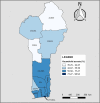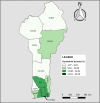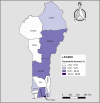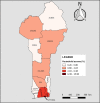Household access to basic drinking water, sanitation and hygiene facilities: secondary analysis of data from the demographic and health survey V, 2017-2018
- PMID: 35836162
- PMCID: PMC9284778
- DOI: 10.1186/s12889-022-13665-0
Household access to basic drinking water, sanitation and hygiene facilities: secondary analysis of data from the demographic and health survey V, 2017-2018
Abstract
Background: In Benin, access to water, sanitation and hygiene (WASH) remains an issue. This study aims to provide an overview of household access to basic WASH services based on nationally representative data.
Method: Secondary analyses were run using the 'HOUSEHOLD' dataset of the fifth Demographic and Health Survey 2017-2018. The dependent variables were household access to individual and combined basic WASH services. The characteristics of the household head and those related to the composition, wealth and environment of the household were independent variables. After a descriptive analysis of all study variables, multivariate logistic regression was performed to identify predictors of outcome variables.
Results: The study included 14,156 households. Of these, 63.98% (95% CI = 61.63-66.26), 13.28% (95% CI = 12.10-14.57) and 10.11% (95% CI = 9.19-11.11) had access to individual basic water, sanitation and hygiene facilities, respectively. Also, 3% (95% CI = 2.53-3.56) of households had access to combined basic WASH services. Overall, the richest households and few, and those headed by people aged 30 and over, female and with higher levels of education, were the most likely to have access to individual and combined basic WASH services. In addition, disparities based on the department of residence were observed.
Conclusion: The authors suggest a multifactorial approach that addresses the identified determinants.
Keywords: Access; Benin; Determinant; Household; Hygiene; Logistic regression; Map; National data; Sanitation; Water.
© 2022. The Author(s).
Conflict of interest statement
The authors declare no conflict of interest.
Figures





Similar articles
-
Mapping and situation analysis of basic WASH facilities at households in Bangladesh: Evidence from a nationally representative survey.PLoS One. 2021 Nov 4;16(11):e0259635. doi: 10.1371/journal.pone.0259635. eCollection 2021. PLoS One. 2021. PMID: 34735535 Free PMC article.
-
Is Benin on track to reach universal household coverage of basic water, sanitation and hygiene services by 2030?PLoS One. 2023 May 25;18(5):e0286147. doi: 10.1371/journal.pone.0286147. eCollection 2023. PLoS One. 2023. PMID: 37228148 Free PMC article.
-
Effects of household access to water, sanitation, and hygiene services on under-five mortality in Sub-Saharan Africa.Front Public Health. 2023 Apr 27;11:1136299. doi: 10.3389/fpubh.2023.1136299. eCollection 2023. Front Public Health. 2023. PMID: 37181724 Free PMC article.
-
Improving health in the Arctic region through safe and affordable access to household running water and sewer services: an Arctic Council initiative.Int J Circumpolar Health. 2016 Apr 29;75:31149. doi: 10.3402/ijch.v75.31149. eCollection 2016. Int J Circumpolar Health. 2016. PMID: 27132632 Free PMC article. Review.
-
Animal influence on water, sanitation and hygiene measures for zoonosis control at the household level: A systematic literature review.PLoS Negl Trop Dis. 2018 Jul 12;12(7):e0006619. doi: 10.1371/journal.pntd.0006619. eCollection 2018 Jul. PLoS Negl Trop Dis. 2018. PMID: 30001331 Free PMC article. Review.
Cited by
-
Understanding Households' Willingness to Pay for Improved Sanitation Services in Benin: A Study Protocol.Environ Health Insights. 2024 Feb 4;18:11786302241228954. doi: 10.1177/11786302241228954. eCollection 2024. Environ Health Insights. 2024. PMID: 38323117 Free PMC article.
-
Access to Drinking Water, Sanitation, and Hand Hygiene Facilities in the Peri-Urban and Informal Settlements of Hosanna Town, Southern Ethiopia.Environ Health Insights. 2023 Aug 29;17:11786302231193604. doi: 10.1177/11786302231193604. eCollection 2023. Environ Health Insights. 2023. PMID: 37655235 Free PMC article.
-
Effects of the level of household access to water, sanitation and hygiene on the nutritional status of children under five, Benin.BMC Nutr. 2023 Aug 1;9(1):95. doi: 10.1186/s40795-023-00751-8. BMC Nutr. 2023. PMID: 37528455 Free PMC article.
-
Household Sanitation and Crowding Status in Addis Health and Demographic Surveillance System (Addis-HDSS) in Addis Ababa, Ethiopia.Ethiop J Health Sci. 2024 Dec;34(Spec Iss 2):84-90. doi: 10.4314/ejhs.v34i2.3S. Ethiop J Health Sci. 2024. PMID: 39911640 Free PMC article.
-
Generalized linear mixed model approach for analyzing water, sanitation, and hygiene facilities in Bangladesh: Insights from BDHS 2022 data.PLoS One. 2025 Jul 10;20(7):e0318467. doi: 10.1371/journal.pone.0318467. eCollection 2025. PLoS One. 2025. PMID: 40638680 Free PMC article.
References
-
- UN General Assembly. The human right to water and sanitation : resolution / adopted by the General Assembly. 2010.
-
- United Nations. The 17 Goals | Sustainable Development. https://sdgs.un.org/goals. Accessed 19 Dec 2021.
-
- World Health Organization, United Nations Children’s Fund (UNICEF). Progress on household drinking water, sanitation and hygiene 2000–2020: five years into the SDGs. Geneva: WHO; 2021.
-
- World Health Organization, United Nations Children’s Fund (UNICEF) Progress on drinking water, sanitation and hygiene 2017 update and SDG baselines. Geneva: WHO; 2017.
MeSH terms
Substances
LinkOut - more resources
Full Text Sources
Medical

